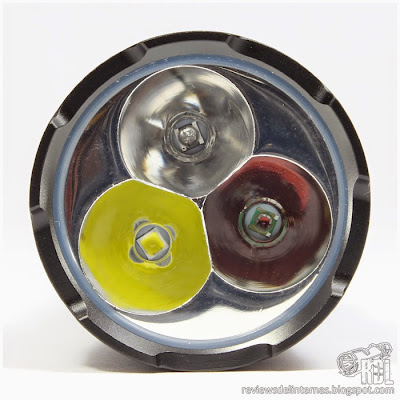RAYUS A10 WRB
LED: CREE XP-L V5, XP-E P3, XT-E Q
Battery: 1x 18650, 2x ® CR123A
Modes: 4 (Low, Medium, High and Turbo per color) / Strobe, SOS, Police Strobe.
Switch: Forward at tailcap, side switch for modes.
Date: December 2014
Rayuslight.com • RdL • ForoLinternas
INTRODUCTION:
Rayus is a young manufacturer who has recently burst onto the scene with some interesting proposals that directly target the premium sector. Among the flashlights that this brand marketed already, the A10 is one of those that make you to look at them. A small multicolored flashlight, which employs three emitters with dedicated reflectors, to offer a different solution to what other brands repeat insistently by incorporating small 5mm emitters inside reflectors not optimized for them.
To cover a wide range, Rayus sells this flashlight in three versions: WGB (White, Green and Blue) WRG (White, Red and Green) and finally, the model that today we will be reviewing, the WRB (White, Red and Blue).
The presentation of the flashlight is minimalist. Inside a small white cardboard box we found the flashlight, along with a holster of textile finishing, wrist strap, a bag containing a set of spare o-rings and button, and user manual.
EXTERIOR FINISH:
Flashlight external appearance is similar to many “tactical” lights, with very compact dimensions with 45mm bezel and a total length of 144mm.
Aluminum has a matte black anodized HA III finish, pretty uniform across all the components of the flashlight. Machining is discreet, no big dissipating fins or sharp angles.
The flashlight head has smooth finish, with subtle side recesses that would prevent the flashlight rolling if we dispense from the “cigar grip” installed between the tailcap and tube. The bezel is slightly crenellated, and also aluminum.
Glass lens protects a peculiar smooth reflector, which have three totally independent light sources. All emitters are correctly centered.
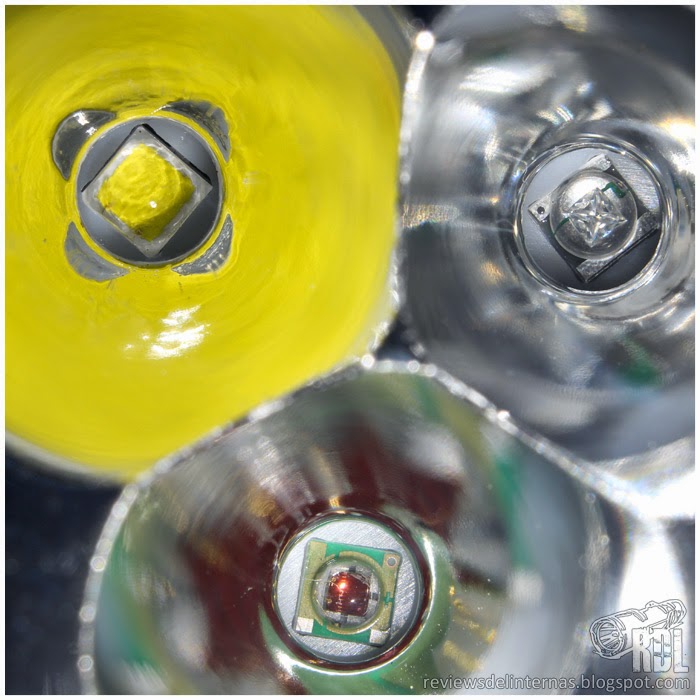
Each of the three LEDs is responsible for a different color, and in this WRB found three different CREEs: XP-L is in charge for the white light, an XT-E for the blue and XP-E for red.

Outside there is a side button, responsible for changing modes, surrounded on both sides of discrete cooling fins. Inside, we find the driver, which has a spring for contact with the positive pole of the battery, so this flashlight admits button and flat tops without problem.
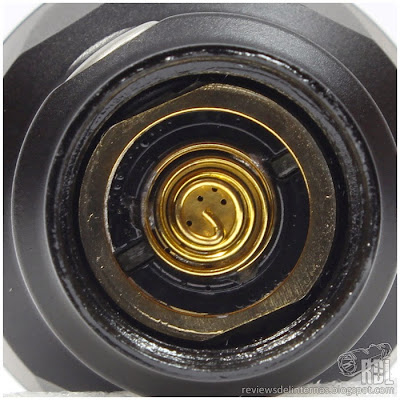
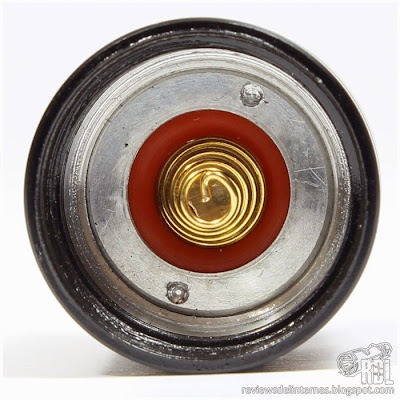
The threads, anodized and square cut, come clean and lightly greased.

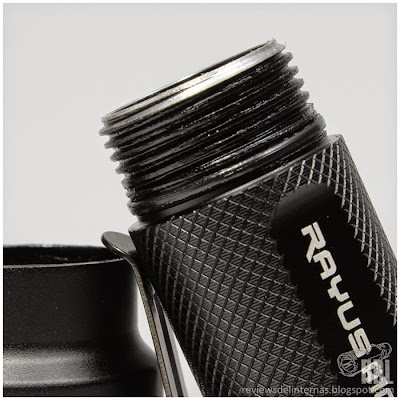
The tube features a smooth knurling, in which both sides are machined two planes, one being the venue for engraving logo and model in white letters that stand in great contrast on the black background.
At the junction with the tailcap find a track to accommodate the clip, which is hold by pressure. The clip is strongly secure and hardly will come out without noticing. Next the clip is found the “cigar grip” ring which is machined in the same material as the light, and is threaded, so it is firm and does not rotate. In addition to facilitate gripping of the flashlight this ring also prevent rolling, and has drilling to secure a wrist strap or any other attachment.
The flashlight tailcap has two battlements that surround the main switch, both perforated to allow anchor points to the wrist strap. Instead the a classic knurling on the tailcap, Rayus opted for some tracks in latitudinal direction, although not as effective as the classic solution facilitate gripping of the part when unscrew to change batteries. The forward switch has excellent feel with momentary activation to about 50% of its travel before reaching the click.
USER INTERFACE:
The user interface is simple enough for this type of multicolor flashlight. We have three independent light sources, each with specific properties for different applications or situations. White light obviously is a multipurpose solution. The blue light provides a unique contrast in which we can easily identify traces of blood. Apparently the blue light is also used for night fishing because it is said it doesn’t perturb fish (there are even rumors that this type of wavelength attracts them). The red light is famous for helping us preserve our visual adaptation to darkness, so we will not blind ourselves with a low red output in complete darkness as would the white light.
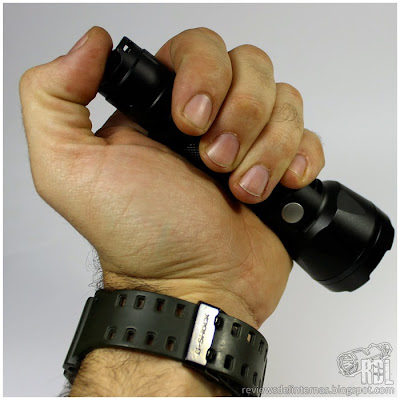
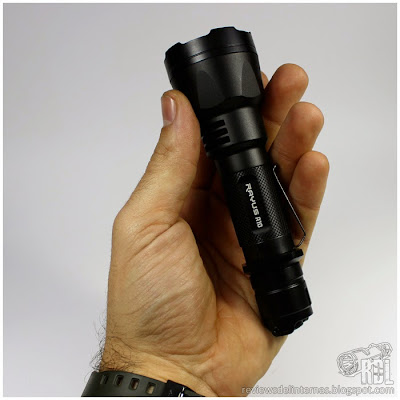
- On and off: The A10 turns on and off using the forward switch on the tailcap.
- Momentary On: This switch can turn the flashlight momentarily on, for short activations or signal/morse code without holding the button until the click.
- Changing Modes: The modes are changed using the side switch on the head. With the flashlight on, press the button to toggle between modes in ascending order.
- Color Selection: To switch between the different colors, you have to hold the head side switch by just over a second. Each color has 4 different modes, toggled in the same fashion as described above.
- Special modes: To access strobe modes, you must press and hold the side switch for about two seconds. The first we found is the white light strobe mode. Pressing the button again will access the SOS mode, which also uses white light to emit the signal in morse code. Finally, repeat the operation again for the police strobe mode, in which the red and blue light will alternate in quick flashes.

- Memory: The flashlight has memory for mode color. If we turn off the flashlight, the next activation will be in that mode and color. Special strobe modes lack memory.
- Block-out: The A10 can be blocked mechanically by partially unscrewing any of its threads. Being anodized, we interrupt the circuit and avoid accidental or involuntary activation.
- Battery status: We can know the state of charge of the battery easily, simply by making a quick double click on the button head on any low mode. The flashlight emits a series of flashes, 3 for a charge state of 75% or higher, two for 50% and one for 25%. This function only works for 18650 battery.
As has happened in the past, we again use the integrating sphere with colored light, so the data for the non-white outputs has to be readed with ‘a grain of salt’:
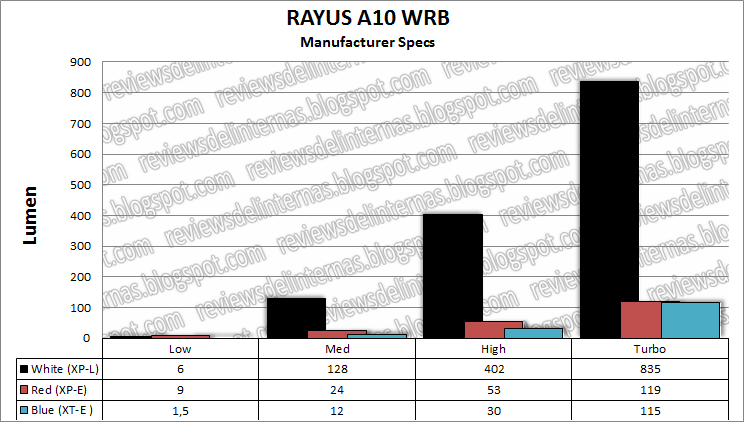
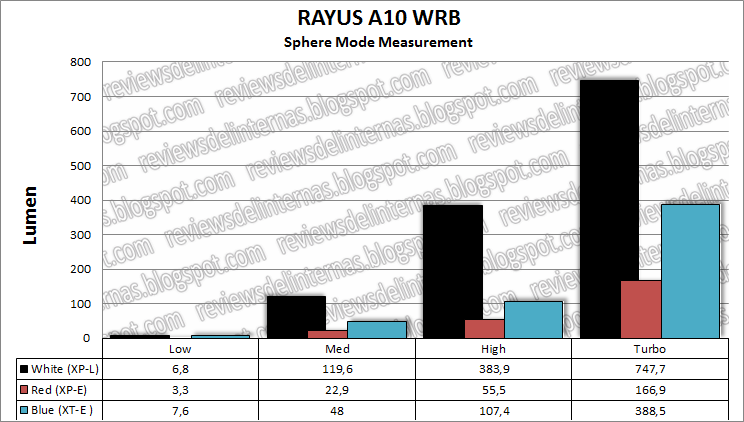
(All measurements are taken following ANSI NEMA FL1 procedure, taking value of the highest reading between 30 and 120 seconds after activation. More details here)
I decided to make the comparison in two separate graphs. In the first we see, illustrated by bars, the distribution of intensities which the manufacturer claims for each color. In the second, the results obtained from measurements on my home made integrating sphere calibrated for white visible light. In white color consistency is pretty good, with a slight downward trend in all modes. In the blue and red colors we see major differences, so it is clear that the result is unreliable.
PERFORMANCE:
The Rayus A10 offers an interesting feature when running in Turbo mode, instead of managing performance through a timed stepdown, has a temperature sensor that lower the output if it exceeds a “critical” point. So, if environmental conditions permit, it is capable of operating in Turbo mode without interruption.
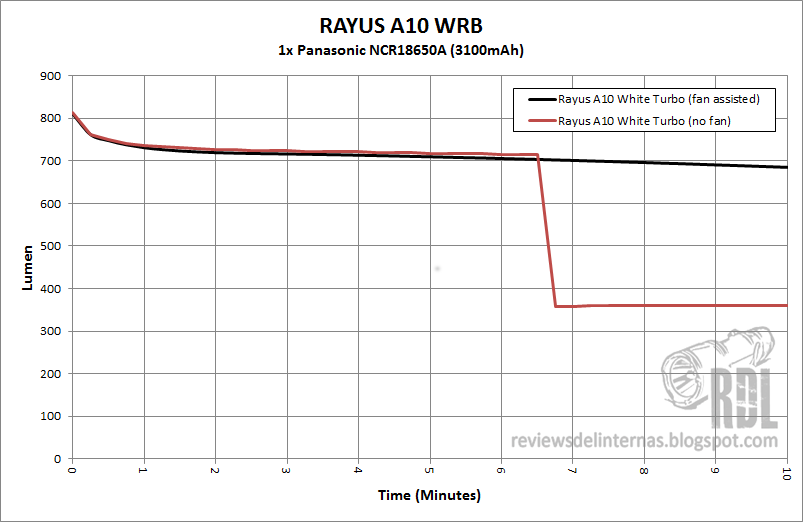
In this graph we can compare performance between the same test performed in two ways, first with the assistance of a small fan that has kept the flashlight cold during the process, and an identical test in which there has been no fan help and flashlight has rapidly heated.
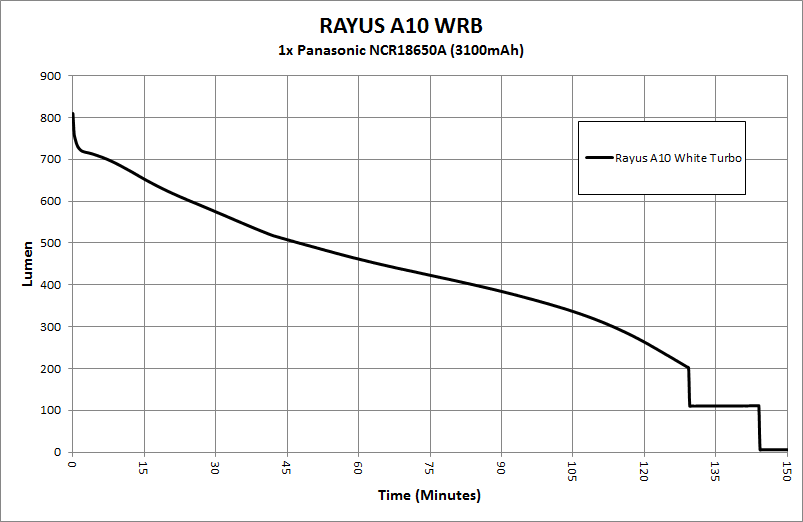
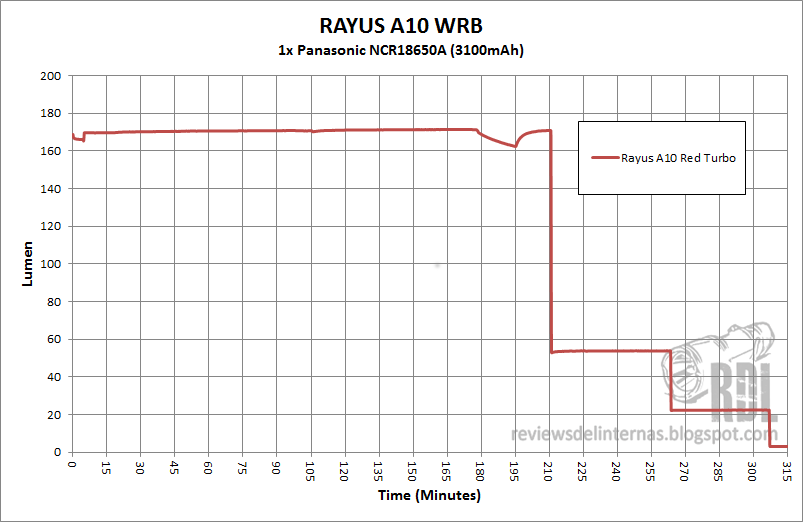
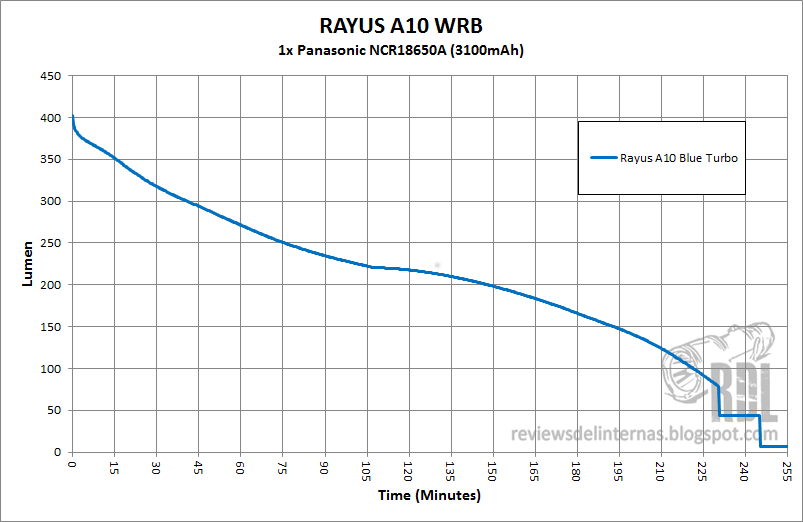
We can see different lines, different regulation depending on the color we use.
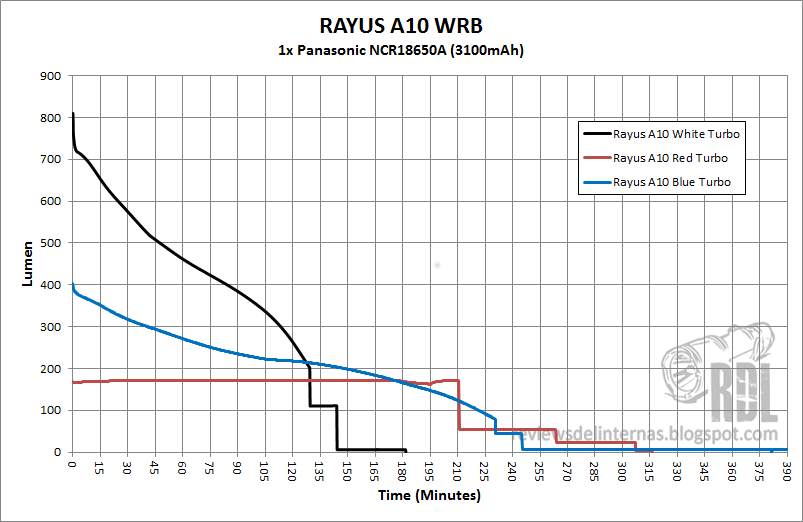
Overall, the performance of XP-L is very similar to typical XM-L2, only in a smaller package (although maintains its emitting surface area).
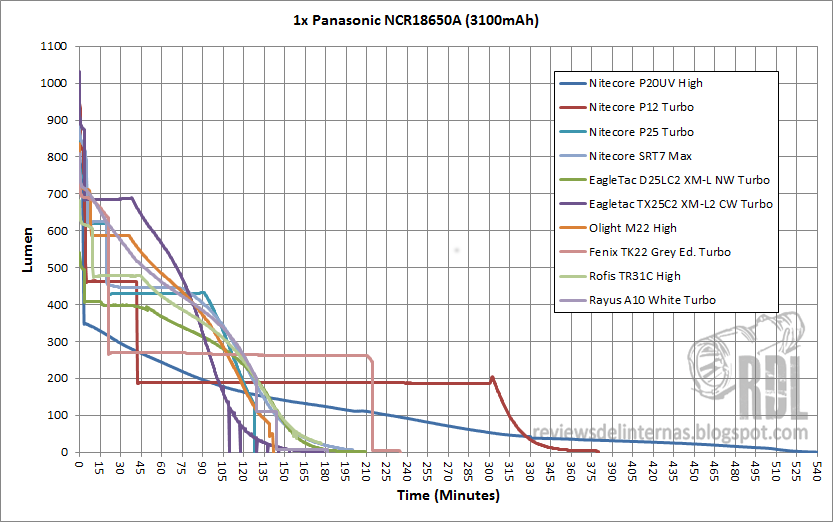
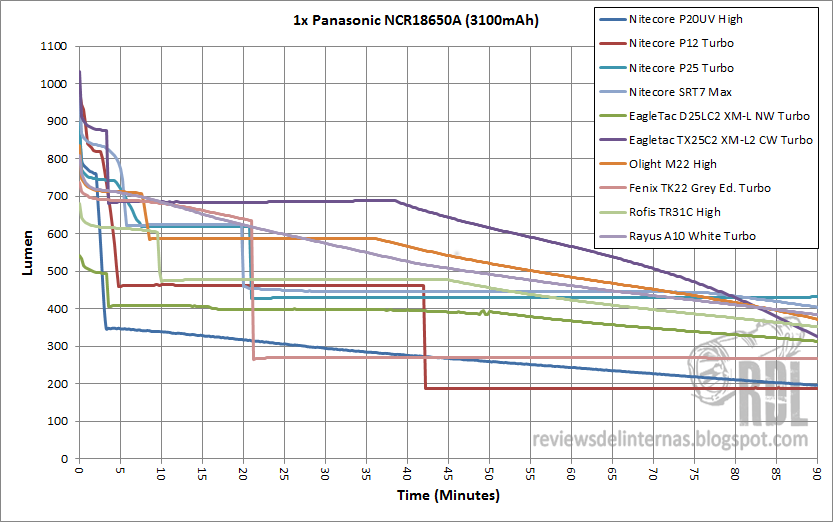
Compared to other flashlights of similar size and power, the A10 offers excellent performance in its white light.

Facing the Chameleon CR6 with red light he A10 has higher output throughout the regulation, and evidently shorter runtime.
BEAM PROFILE:
By using separated reflectors, the Rayus A10 seeks to offer an alternative with a decent beam profile within the multicolor flashlight segment.




As in the CR6, the smooth reflector partially overlaps at its center, but in this Rayus the overlap of the reflectors is rather less pronounced.






The beam is clean with a well-defined hotspot and uniform spill. We see there is a slight imperfection on the edges of the profile, caused by the effect of the overlapping, although this effect is much less marked than in the CR6, and virtually inappreciable away from the white walls.
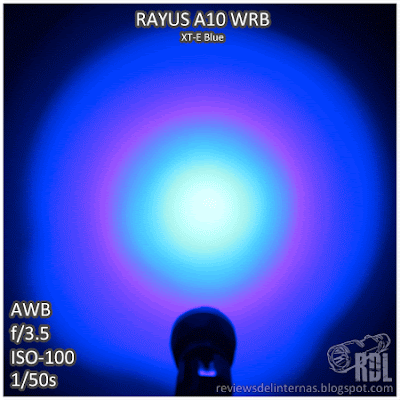







PERSONAL CONCLUSION:
Rayus, even as a young manufacturer, counts among its crew with some brains that come from leading companies in the industry, so they have got a very good start by begin offering very interesting flashlights since its inception.
This A10 WRB is an excellent example of how a company rejects the current conformism that many are summed with the “fashion” of including small 5mm multicolor LEDs embedded in the reflector, and gives us the opportunity to enjoy color light of a powerLED into a flashlight.


Rofis TR31C • Rayus A10 • Nitecore CR6 Chameleon • Fenix TK22 GE • Nitecore P20UV
Its size can be misleading, since in the classic format of a “tactical” flashlight have a small multiLED, which instead betting on extreme white light output using all emitters for the same color, offers a real alternative within the field of compact multicolor tool.
Negatives: I find it curious that instead of having his head slightly enlarged or decreased the effective diameter of the reflectors to incorporate the four colors in a single flashlight, Rayus has decided to market three models, each with a different combination. I also see with some concern that, while apparently designed for it, the flashlight cannot be placed in tailstand.
Positives: I especially like the simple construction of the flashlight, with no sharp lines in the machining of your body. Mechanical finish fall short of the big names in the industry, and attention to detail is palpable. Extremely versatile with a simple yet comprehensive user interface. Excellent color performance, multiple modes for the three color outputs.
Rayus A10 sample provided by Rayus for review. Thanks!





